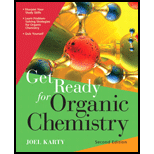
(a)
Interpretation:
The complete IUPAC name of the given molecule is to be written.
Concept introduction:
Both
The main chain or ring is the one that contains the highest-priority functional group. The next step is to number the main chain or ring such that the carbon atoms involving the highest-priority functional group receive the lowest possible numbers. The locator number for the highest-priority functional group is written immediately before the suffix, unless needed. All other
For a molecule that contains only an aldehyde as a functional group requires dropping the final e and adding the al suffix.
For a molecule containing both an aldehyde and a ketone as functional groups, a locator number is added for the ketone but not for the aldehyde.
For a molecule containing more than one aldehyde or ketones functional groups, the e in ane is retained.
Note that for a cyclic aldehyde, the
(b)
Interpretation:
The complete IUPAC name of the given molecule is to be written.
Concept introduction:
Both ketones and aldehydes contain a
The main chain or ring is the one that contains the highest-priority functional group. The next step is to number the main chain or ring such that the carbon atoms involving the highest-priority functional group receive the lowest possible numbers. The locator number for the highest-priority functional group is written immediately before the suffix, unless needed. All other functional groups in the molecule are treated as substituents and appear in the name as a prefix. Prefixes such as di, tri, tetra, etc., are used to indicate the number of identical substituents attached. The substituents are named in the alphabetical order. A locator number is added for the ketone but not for the aldehyde.
For a molecule that contains only an aldehyde as a functional group requires dropping the final e and adding the al suffix.
For a molecule containing both an aldehyde and a ketone as functional groups, a locator number is added for the ketone but not for the aldehyde.
For a molecule containing more than one aldehyde or ketones functional groups, the e in ane is retained.
Note that for a cyclic aldehyde, the
(c)
Interpretation:
The complete IUPAC name of the given molecule is to be written.
Concept introduction:
Both ketones and aldehydes contain a
The main chain or ring is the one that contains the highest-priority functional group. The next step is to number the main chain or ring such that the carbon atoms involving the highest-priority functional group receive the lowest possible numbers. The locator number for the highest-priority functional group is written immediately before the suffix, unless needed. All other functional groups in the molecule are treated as substituents and appear in the name as a prefix. Prefixes such as di, tri, tetra, etc., are used to indicate the number of identical substituents attached. The substituents are named in the alphabetical order. A locator number is added for the ketone but not for the aldehyde.
For a molecule that contains only an aldehyde as a functional group requires dropping the final e and adding the al suffix.
For a molecule containing both an aldehyde and a ketone as functional groups, a locator number is added for the ketone but not for the aldehyde.
For a molecule containing more than one aldehyde or ketones functional groups, the e in ane is retained.
Note that for a cyclic aldehyde, the
(d)
Interpretation:
The complete IUPAC name of the given molecule is to be written.
Concept introduction:
Both ketones and aldehydes contain a
The main chain or ring is the one that contains the highest-priority functional group. The next step is to number the main chain or ring such that the carbon atoms involving the highest-priority functional group receive the lowest possible numbers. The locator number for the highest-priority functional group is written immediately before the suffix, unless needed. All other functional groups in the molecule are treated as substituents and appear in the name as a prefix. Prefixes such as di, tri, tetra, etc., are used to indicate the number of identical substituents attached. The substituents are named in the alphabetical order. A locator number is added for the ketone but not for the aldehyde.
For a molecule that contains only an aldehyde as a functional group requires dropping the final e and adding the al suffix.
For a molecule containing both an aldehyde and a ketone as functional groups, a locator number is added for the ketone but not for the aldehyde.
For a molecule containing more than one aldehyde or ketones functional groups, the e in ane is retained.
Note that for a cyclic aldehyde, the
Want to see the full answer?
Check out a sample textbook solution
Chapter E Solutions
Get Ready for Organic Chemistry
 Organic And Biological ChemistryChemistryISBN:9781305081079Author:STOKER, H. Stephen (howard Stephen)Publisher:Cengage Learning,
Organic And Biological ChemistryChemistryISBN:9781305081079Author:STOKER, H. Stephen (howard Stephen)Publisher:Cengage Learning, General, Organic, and Biological ChemistryChemistryISBN:9781285853918Author:H. Stephen StokerPublisher:Cengage Learning
General, Organic, and Biological ChemistryChemistryISBN:9781285853918Author:H. Stephen StokerPublisher:Cengage Learning




